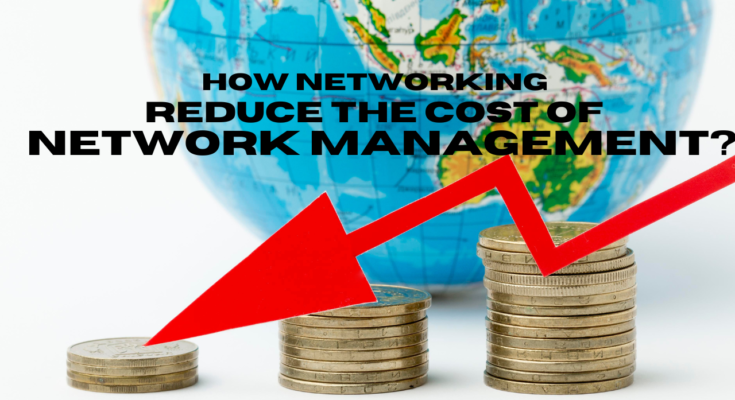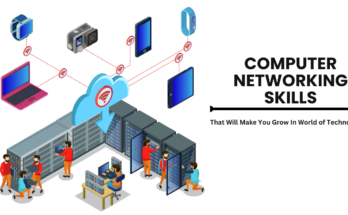How networking reduce the cost of network management?
Networking in Business:

Networking in business is establishing and sustaining relationships with people and organizations both inside and beyond one’s industry. It comprises mutual assistance, information exchange, and collaboration on many initiatives. There are several types of networking, including official associations, casual meetings, and internet groups.
The advantages of networking in business are numerous. It creates new possibilities, promotes information sharing, and offers access to important resources and skills. Furthermore, networking increases brand awareness and reputation, which are critical for acquiring clients and investors.
Cost Reduction Through Networking
One of the most major benefits of networking reduce the cost. Businesses can use their networks to access resources and shared services, thus reducing significant expenses. For example, co-working spaces allow multiple companies to share office space, reducing overhead costs such as rent and utilities.
Also, the Internet allows companies to negotiate prices and discounts with suppliers and service providers. By pooling their purchasing power, businesses are better able to negotiate terms and prices, resulting in better profits. Another way to spend money using the Internet is through cooperative purchasing, where many companies come together to buy goods or services in bulk.
Tips for Effective Networking
- Networking reduces costs for firms through efficient relationship-building and maintenance methods.
- Prioritize relationship-building over transactional encounters to establish strong connections.
- Real connections are built on trust and mutual respect.
- Focus on communicating more about your business rather than solely seeking help.
- To attend seminars, conferences, and business meetings that help to expand your network and create important and valuable connections.
- connection with your colleagues to exchanging ideas and learning from each other.
- Through networking, companies can discover new ways to reduce costs and facilitate growth.
Case Studies
Several firms have effectively lowered expenses by using strategic networking activities. For example, a group of small enterprises in the same sector established an alliance to buy raw materials at a reduced cost from suppliers. This joint strategy not only cut procurement expenses, but also increased their negotiating power during negotiations.
In another case, a business used its network of industry contacts to gain mentorship and advise from seasoned entrepreneurs. By using the experience and skills of seasoned people, the business avoided costly mistakes and accelerated its growth trajectory.
Networking Reduce the Cost of network management:
Today’s current networking technologies and designs are intended not just to increase network performance, but also to transform how networking reduce the cost, monitored, managed, and hence budgeted.
Automation:

Automation is based on next-generation networking, including software-defined networking (SDN) and network functions virtualization (NFV). This technology provides centralized management and control of network resources, allowing administrators to update configurations and configurations and troubleshoot performance issues. Automation removes the need for human intervention, saving network administrators time and effort while cutting operational costs. Some of our clients have saved up to 50% of their network engineers’ time; just take a look.
Network Programmability
Next-generation networks include programmable interfaces and APIs (Application Programming Interfaces), allowing network administrators to create bespoke apps and scripts to control the network. This programmability enables the development of network management tools and applications adapted to individual requirements, speeding management operations and lowering the expenses associated with third-party software or difficult manual settings.
Simplified Operations
Cisco Meraki dashboard is a prime example of a next-gen networking solution that simplifies operations by abstracting complicated infrastructure and offering user-friendly control interfaces. Our clients have reported that this simplicity makes it easier for network managers to configure and administer the network, lowering the learning curve and potential mistakes. Simplified operations can result in cheaper training expenses, faster onboarding of new administrators, and fewer errors that could cause costly network outages.
Centralized Monitoring and Analytics
Next-generation networking systems usually include centralized monitoring and analytics capabilities. These tools capture real-time data from network devices and give detailed information about network performance, utilization, and security. By obtaining visibility into network behavior and proactively recognizing possible concerns, network managers may optimize network resources, efficiently plan capacity increases, and reduce the chance of expensive network failures or breaches.
Cloud-Based Management:

Cloud-based management platforms are frequently used in new-generation networks and provide scalability, flexibility and cost-effectiveness. Cloud management eliminates the need for on-premises infrastructure while reducing hardware and maintenance costs associated with traditional network management solutions. Furthermore, cloud-based management solutions enable centralized access to network management tools from anywhere, allowing for effective remote network administration while lowering trip costs.
Network Function Virtualization (NFV)
- Next- generation networking uses NFV that means Network Functions Virtualization, to detach network services from high-end hardware and allow them to operate as software-based virtual machines.
- NFV facilitates cost reduction by consolidating network services onto fewer hardware devices, thereby lowering power consumption, hardware maintenance, and upgrade expenses.
- It enables dynamic scaling of network services, allocating resources as required to optimize costs according to demand fluctuations.
Other ways: Networking Reduce the Cost of network management:
| Aspect | Description |
|---|---|
| Hardware Consolidation | Network functions are virtualized, reducing the need for multiple hardware devices. |
| Power Consumption | Virtualization lowers power usage compared to traditional hardware setups. |
| Maintenance Expenses | With fewer physical devices, there are fewer components to maintain and replace. |
| Upgrade Costs | Upgrades can be implemented more efficiently in software-based environments. |
| Dynamic Resource Scaling | Resources can be allocated dynamically, optimizing costs based on demand fluctuations. |
Challenges in Networking
While networking has tremendous advantages, it is not without obstacles. Building and maintaining connections takes time and effort, and not every connection produces immediate dividends. Furthermore, firms may face rivalry inside their network, making it difficult to negotiate exclusive deals or collaborations.
Overcoming these obstacles needs patience, perseverance, and a deliberate approach to networking. Businesses can negotiate the challenges of networking and gain the long-term benefits by concentrating on making real connections, adding value to others, and being open to cooperation.
Conclusion
In conclusion, networking reduce the cost and develop your firm. Businesses may achieve long-term success by building relationships, sharing resources, and cooperating with others. In today’s changing company world, adopting networking as a strategic priority may not only save costs but also boost innovation, resilience, and competitiveness.
FAQs
How does networking benefit small businesses?
Networking connects small companies to valuable resources, expertise, and opportunities that would not otherwise be available. Small businesses can overcome challenges, expand their reach, and thrive by collaborating with peers, vendors, and mentors.
What are some common networking mistakes to avoid?
Common mistakes in networking include promoting yourself, forgetting to follow, and not adding your connections. It is important to connect with honesty, humility, and a desire to have a lasting relationship.
Can networking help businesses during economic downturns?
Yes, networking may be especially useful during economic downturns. Businesses may leverage their network to gain access to assistance, resources, and opportunities that will help them weather the storm. Collaboration and partnerships formed via networking can also promote resilience and creativity.
How can businesses measure the ROI of networking activities?
While the ROI of networking efforts is not always immediately measurable, firms may monitor indicators such as new leads produced, partnerships developed, and cost savings gained through networking programs. Long-term benefits, such greater brand awareness and industry impact, should also be considered.
What role does technology play in modern networking?
Technology is very important to today’s internet because it enables communication, collaboration and connection between the world. Businesses can use social media platforms, online forums, and online tools to expand their reach, engage a broader audience, and build relationships regardless of location.



